|
|||||||||
|
ARTICLESWolf Smoke Signals War Fig. 1 The wolf enclosure, People's Park, Yining, Xinjiang-Uygur Autonomous Region. [BGD] The outbreak of war is described in ancient and modern literary Chinese as 'wolf smoke rising around us' (langyan si qi). The expression 'smoke of the wolf' (langyan), which first made its appearance in literature in the 9th century, seems both an apt and evocative metaphor for warfare. The wolf has negative connotations in the Chinese language, and a plethora of lupine expressions encapsulate the full range of human ambition, treachery, viciousness and rapacity. However, it was not the panting breath of the predatory wolf that gave rise to the term. The generally accepted explanation of the origins of the expression is that 'wolf smoke' is a reference to frontier beacon fires burning dried wolf dung to warn of the approach of an invading enemy. The wolf roamed the remote steppe and forests north of China, and in these sparsely inhabited areas the wolf has few natural enemies, except man. (Fig. 1) The deserts and grasslands of the north and north-west are also thinly vegetated, and so it is credible that dried wolf dung recommend itself as a fuel to soldiers living in near exile on the frontier who were required to man the elaborate lines of beacon towers that were China's early warning defence system from the late Warring States period onwards. (Fig. 2) But the traditional explanation of the expression 'wolf smoke' is far more convoluted. 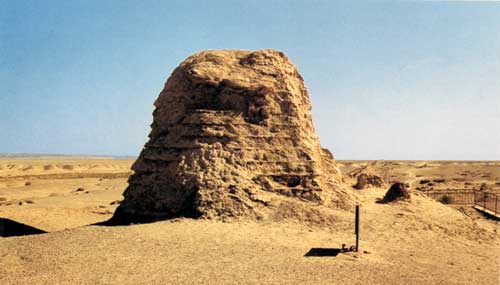 Fig. 2 The remains of Danggu sui (beacon tower) in the vicinity of Dunhuang, Gansu province. The Beacon System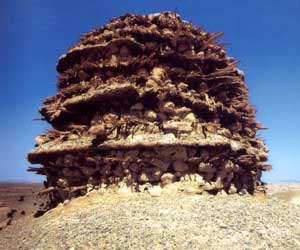 Fig. 3 The remains of the Mahuajia sui (beacon tower), Gansu province. A system of beacon towers, forts, walls and ditches was gradually constructed along China's northern borders to thwart potential invasions by the Xiongnu and Dong Hu peoples, to name only the most significant of the earliest Eurasian nomadic groups. The beacon towers (known variously in Chinese as sui, feng, fenghoutai, fenghuotai, fengsui or yandun) (Fig. 3), facilitated the relay of military intelligence and other information across the frontier by means of smoke signals by day and torch by night. The beacon towers were an integral part of the Great Wall defensive systems. The number of smoke signals or the number of times torches were raised or lowered served to relay information regarding numbers of approaching enemy troops. The archaeological and historical records have provided a considerable amount of information about the beacon systems of different periods, especially those of the Han and Ming dynasties. Statutes and military manuals from the Ming dynasty provide details of the rosters of troops at beacon towers, the protocol of signalling, the inclusion of cannon fire and drums within the repertoire of traditional smoke and fire signals, and some information on the fuel used for fires. We know that one Ming dynasty innovation was the addition of sulphur and saltpetre to beacon fires, so that clearer and more rapid information could be relayed. The Beacon Fires of Dunhuang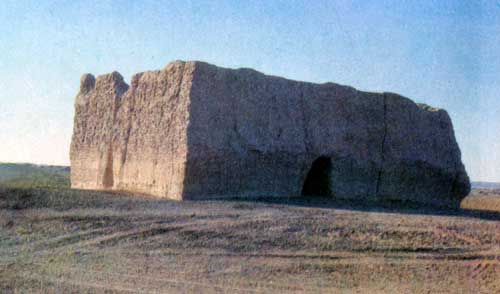 Fig. 4 Yumenguan, Jade Pass, was a major strategic pass in the Han dynasty Great Walls. It is located in the north-west of Dunhuang county, Gansu province. Most of the information regarding the beacon system of the earlier period from the Han to the Tang dynasty has been gleaned from archaeological research. It is estimated that there were thousands of beacon towers along the historical Great Walls of the north-west, and the number that survive to the present day is also calculated to be in the thousands. At Yumenguan Pass and other sites within the Dunhuang district of Gansu province (Fig. 4), 'tinder piles' called jixindui have been preserved for up to two millennia by the arid climate of the region. (Fig. 5) Archaeologists have examined these piles of fuel intended for use in signal fires. They comprise dried Chinese tamarisk, reeds, diversiform-leaved poplar, the rose willow and other types of vegetation. Only occasionally have they been found to contain animal dung, and never that of the wolf. While some ancient texts describing the composition of the fuel for beacon fires do include wolf dung, it is only mentioned in the context of that of other animals and then only as an additive to the many plants which military manuals recommend that garrison troops use. 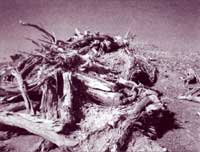 Fig. 5 Jixindui (pile of preserved ancient beacon fire fuel) photographed in the Dunhuang region. Photograph courtesy of Xungen (Root exploration), 2006:2, p.96. According to historical records, these beacon towers would signal by day using smoke formed from burning assorted vegetation, as well as foliage and timber from various local trees, while fires at night were fuelled by reeds. To date eight beacon towers have been discovered in the vicinity of the Yumenguan Gate near Dunhuang at which were found 'tinder piles' dating from the Han dynasty (Fig. 6); at one of these towers there are were 16 bundled up piles of reeds, each approximately 20cm in diameter and 2m in length. These dated from the Han dynasty and did not conform to later measurements.  Fig. 6 A typical large pile of ancient beacon fire fuel dating to the Han dynasty from the Dunhuang area and now housed in the courtyard of the Gansu Provincial Archaeology Institute in Lanzhou. Photograph courtesy of Xungen (Root exploration), 2006:2, p.96. More than 130 ancient beacon platforms have been discovered in the Dunhuang region, and all over China tens of thousands of these sites have been identified by archaeologists. Not only did these beacon towers relay military information, they also issued 'all clear' (ping'an) signals in the morning and at nightfall, according to one Tang text. Yet none of these many sites have been found to contain deliberately piled up wolf dung. This is not to say that wolf dung was not among the many available combustibles that could be burned at the beacon platforms, but the comprehensive lists of combustible materials used at beacon fires that appear in Tang and Song dynasty texts only ever mention wolf dung in combination with the dung of cattle, sheep and other animals, as well as with the wide variety of vegetable matter used at such sites. No text cites wolf dung as a main material. The structure of the beacon platforms was designed so that the smoke or flames could be seen clearly at the next watchtower. Therefore they often had a chimney or flue arrangement to ensure that the smoke could rise as near to vertical as possible and be seen at the next relay station. A Scientific MythLi Zhengyu, an archaeologist and historian from the Dunhuang Institute, has examined the mystery of wolf dung fires for some years, and in the April 2006 issue of the journal Xun gen (Root exploration) presents the first full account of his discoveries. Despite the fact that no wolf dung traces or coprolites have been found by archaeologists, a large unchallenged pseudo-scientific literature grew up to explain what had begun as a literary phenomenon. It came to be believed and documented that smoke from burning dried wolf dung, unlike that from the dried dung of other animals, was not dispersed by the wind, and so the clear straight plume of smoke it gave off made it the ideal medium for signalling the approach of an enemy army because it could be seen over the greatest distance. The dung of the camel was also said to have this property, according to some ancient sources. The early scientific explanation for this property of the smoke of wolf—and camel—dung was based on evidence supplied by the imagined anatomy of the two animals. Writers maintained that the intestinal tract of both animals was not convoluted, allowing for swift and direct digestion, which translated into the straight plumes of smoke that rose from their burning dried dung. Prior to the days of modern anatomy, this view went unchallenged. By the Ming dynasty (1368-1644), leading scientists, including Li Shizhen, Fang Yizhi and Xu Guangqi, all accepted the view that dried wolf dung was used for military signal smoke because it rose vertically into the air echoing the straight alignment of the wolf's intestines. Overlooking the white magic implicit in this explanation, the information came to be enshrined as 'canon' in a quotation included in The Great Kangxi Dictionary. Even Qi Jiguang (1528-1587), the renowned Ming general associated with the Great Wall defences to the north and north-east of Beijing, paid lip service to the virtues of wolf dung fires, but he quite pointedly did not recommend its use in any of his detailed notes on maintaining beacon fires. Li Zhengyu has tested the properties of burning dried wolf dung and compared it with that of other animals. He demonstrated to his own and his colleagues' satisfaction that the claims for dried wolf dung are utterly spurious. Moreover, the anatomical details concerning the similarities of the digestive tract of the camel and wolf are risible. Above all, there is next to no archaeological evidence that dried wolf dung was burned in beacon fires, except in insignificant amounts. The Textual Evidence from Dunhuang Fig. 7 View of the Mogao Grottoes at Dunhuang. 'The smoke of the wolf' first made its appearance in poetry of the late-Tang period composed by Du Mu, Li Shangyin and other less well-known poets. Almost all the poetry treats border themes, but works prior to the late-Tang which mention 'beacon fires' and 'war signals' do not use the epithet 'wolf smoke'. The term langyan first makes its appearance in the late-Tang period and then only in lyric verse or more formal poetry; it does not appear in any prose works, including official documents, treatises, essays or letters. The term therefore originally had only lyrical import. In the subsequent Five Dynasties period, the situation changes, if only to a limited extent. Li Zhengyu can only identify four prose passages produced in the Central Plains area that contain the term. However, the situation is different when we examine writings produced during the Five Dynasties period (907-960) in China's far west. Among the vast library of writings in many different languages unearthed at Dunhuang, langyan appears in various linguistic media. At least ten instances occur in the manuscripts collected at Dunhuang by Paul Pelliot and Aurel Stein a century ago. (Fig. 7) The Threat to the FlockExamining the content of warfare in these various references and relating them to historical events which they describe, Li Zhengyu concludes that the wolf is used in these poems as a metaphor for various northern ethnic groups. From the time of the reign of Emperor Gaozong (r. 650-683), the Tang dynasty was engulfed in a series of wars, beginning with the conflicts with the Turks. From the Tianbao period (742-755) onwards, the rebellions led by An Lushan and Shi Siming were to plunge the Tang empire into chaos, from which it would never recover. An Lushan has been identified as a Turk, or more recently as a Sogdian, his given name being an equivalent of the Central Asian name Roxana. While the rebellion of An Lushan still raged, Tubo (Tibetan) armies occupied much of the west and in 763 even entered the capital, Chang'an. In the following year the Shuofang Military Commander, Pugu Huai'en, of the Tiele ethnic group, also rebelled and formed an alliance with the armies of the Tubo and the Huihe (Uyghurs) to attack Fengtian, Liquan, Fenzhou and Xingyang. In 766, the Tubo made further advances and again threatened the capital. Henceforth the Tibetans were constantly on the offensive; Dunhuang, Beiting, Kucha, and Khotan fell to their armies. 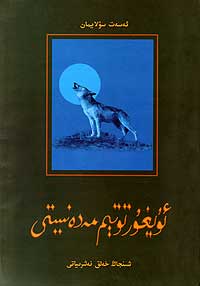 Fig. 8 Cover of a recently published study on wolf totems, focusing on the significance of the wolf in Uyghur culture. Aisait Sulaiman, Uyghur totemic culture, Urumqi: Xinjiang People's Publishing House, 2000. Li Zhengyu draws attention to the fact that the wolf was a highly regarded, if not the most highly regarded, animal of most of these ethnic groups. The wolf figured prominently in the religious beliefs of the Turks, the Uyghurs, the Tiele and the Tuyuhun, all groups with which the Tang fought border wars. Li discusses this identification with the wolf, as a 'totemic' phenomenon. (Fig. 8) The word 'totem' has been much abused in Chinese anthropological writing for the last two decades, but there is no denying the significance that the wolf played in what might be better termed the heraldry of the four ethnic groups. Contemporary documents describe how the wolf was emblazoned on the banners these peoples carried into battle. Li identifies many poems in which the smoke of war is linked to 'the Bo-Hun', a poetic abbreviation of Tubo-Tuyuhun. The Tubo is an ancient name of the Tibetans, and together with the Tuyuhun they controlled the Gansu corridor and Qinghai for a period of nearly two centuries from the late Tang through to the Five Dynasties. Li notes that the Tibetans also used the wolf on their banners. Etymology often entails speculation, but Li Zhengyu's arguments accurately tie the first textual appearances of the expression he is examining to events in that period of Chinese warfare. [BGD] |